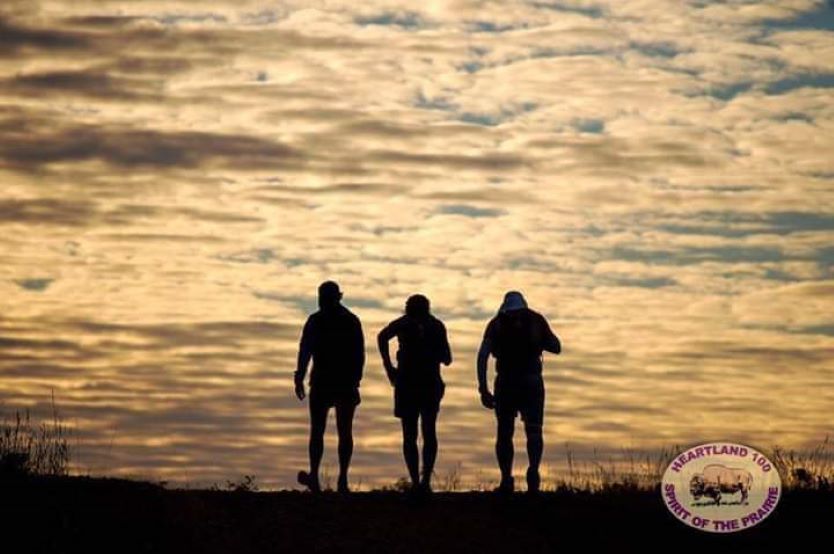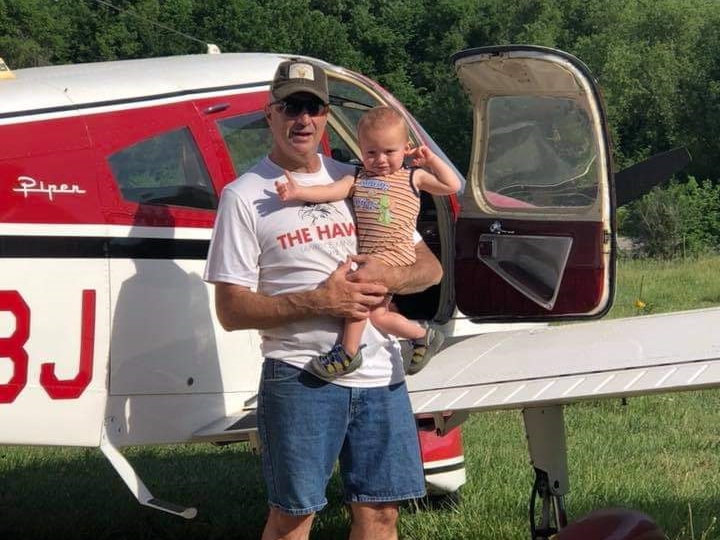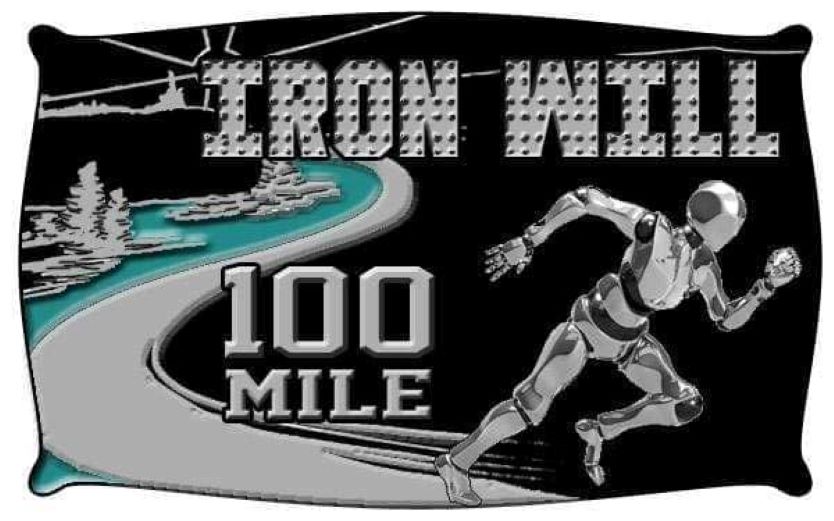Out of the blue and at the peak of his fitness, ultrarunner and race director Will “Iron Will” Sprouse’s face began to droop. His words started to slur together, an employee told him. He rushed from his restaurant, which he owns and operates, to the hospital.
Since experiencing a sudden stroke in 2020, Sprouse, age 53, has had a massive comeback. Not only did he defy a prescription to learn to live in a wheelchair, but he learned to walk and run again and continues to race his favorite 100-mile distance today, despite challenges with managing his heart rate and balance. Through the experience, he designed an adaptive-friendly 100-mile race, the Iron Will 100 Mile, which will debut on September 10, 2022, in Kansas, his home state.
What stands out about Sprouse, however, is his ability to stay positive and overcome life-defining challenges, which he’s faced several times throughout his life.
Sprouse’s dad was in the U.S. military. Sprouse was born and raised in Germany, and his family moved to Fountain, Colorado, when he was 11 years old. Two years later, they moved to Kansas, which Sprouse still calls home — he lives in Enterprise, Kansas.
After studying aviation mechanics and becoming a pilot, Sprouse ultimately followed a path into restaurant management. To pay off college, he’d started working in restaurants and advanced in the McDonald’s Corporation, where he remained in upper management for 13 years. By then, he’d saved up enough capital to buy and run his own restaurants.
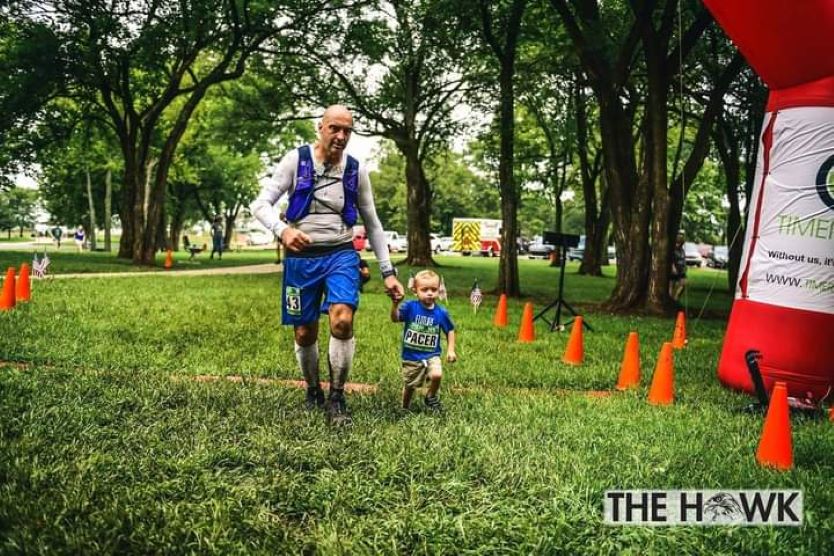
Will Sprouse finishing the Hawk 100 Mile with his grandson, Caysen, as pacer. All photos courtesy of Will Sprouse, unless otherwise stated.
Today, he runs the restaurant Aid Station Pub and Pizza, named as an ode to the aid stations at ultramarathons, in Chapman, Kansas.
“It’s like a sports bar that’s geared toward running. We have 17 craft beers on tap. All of my belt buckles and awards from running are on the wall. My race bibs are epoxied into the countertop of the bar. A lot of people travel through on their way to Colorado to train or race, because of the mountains,” said Sprouse, who wrestled, played football, and ran the quarter-mile distance in track while growing up.
“My dad was a marathon runner and he ran for the U.S. Army. He was pretty good,” he added.
While working for McDonald’s, Sprouse gained weight and was more than 300 pounds. In 2005, after his dad fought and passed away from cancer, Sprouse went through a midlife crisis that catalyzed him to start running. While coping with the loss, he got down to 152 pounds — half of his peak body weight. He ran road marathons for five years.
That was until the Memorial Day weekend of 2010, when another tragedy hit. Sprouse was driving his motorcycle, which he’d ridden since he was a kid, on a highway when a dog jumped out of the weeds. Moving at 60 miles per hour, he flipped over the handlebars.
“I broke 46 bones in my body and had internal injuries. I wasn’t a fast marathon runner; I ran in the 3:50 range. But when I went back to running, I was much slower. My pelvis had broken, and my left side was shorter than my right. I decided to go into trail running, because the surface is uneven anyway, so it didn’t matter that one leg is shorter. And I could move slower in an ultramarathon,” said Sprouse.
His first ultra was the 2012 Rocky Raccoon 100 Mile trail race, on February 4. “Once I ran that 100 miler, I fell in love with the 100-mile race. I’ve done a few 100-kilometer races, 50 milers, and 50ks, but I mostly did 100 milers,” he said.
“The ultrarunning community is just so awesome. They’re all like family. I was so glad to get out of the marathon road racing, because everyone was out for themselves. In ultra events, the championship guys are down to earth and look out for the back-of-the-pack runners. I don’t even know how to describe it. That’s the best thing about races is to meet up with the people you know,” shared Sprouse, who’s been married 33 years, and has three kids and two grandkids, the majority of whom live in Kansas. He also has three younger brothers and 63 first cousins, of which a huge portion live in Colorado. Though his wife and kids don’t run, they help crew some of his races.
To date, Sprouse has completed 74 100-mile races, including many podium finishes and one win at the 2020 Lhotse 100 Mile in Oklahoma, during 118-degree Fahrenheit heat.
“I prepare myself really well for the heat by running in the middle of the afternoon. I have a race this upcoming June 3, and I have more 100 milers in July. I’ll wear a lot of clothing, overdo it, and acclimate my body really well. A lot of people get too hot, and they’ll sit to cool down. But in heat races, I move through them nonstop, slowly, but I make up a lot of ground when people overheat,” said Sprouse.
With a strong record of finishing 100 milers, Sprouse’s ultrarunning trick is to go consistently and continuously and to avoid a fast start. “I’m slow and steady. I don’t go out fast and slow down. In fact, I run the second half faster and my last 25 miles are usually my fastest,” he shared.
After racing dozens of 100 milers across the country, one of the most memorable and challenging events he’s raced is the Cruel Jewel 100 Mile, which he ran in 2018.
The route is “advertised as a 106-mile race but felt like it was closer to 116 miles,” said Sprouse. Though the course is not at high altitude, it features nearly as much elevation gain and loss as the Hardrock 100 — 33,000 feet — but with the added burden of 90% humidity, noted Sprouse.
He said, “I’d run other 100 milers in 22 hours. The Cruel Jewel 100 Mile took me 47 hours — it’s tough, rocky, and steep. I ran two nights without sleep, and I didn’t stop. The mountain races on Colorado trails have switchbacks. Even though the mountains aren’t as aggressive, the Appalachian Mountains’ trails are more aggressive because of how they lay them out: The trails go straight up or straight down.”
At the turn of 2020, Sprouse’s goal for the year was to run 52 100-mile races in a single year, meaning he’d finish a century run every weekend. He’d registered for thirty-six 100 milers, finishing three in January and another three in February before the COVID-19 pandemic hit. Many races were canceled.
“I had zero DNFs. I was knocking out 100 milers left and right. I got second place in the 100 miler in March, the Lhotse 24-Hour Endurance Challenge; third place in a 100 miler in April; second at another in July; then I won the Lhotse 100 Mile in September and got third in another in September: the Tulsa Urban Adventure 100 Mile. Right before Thanksgiving, I finished the Dinosaur Valley 100 Mile in Texas,” recalled Sprouse.
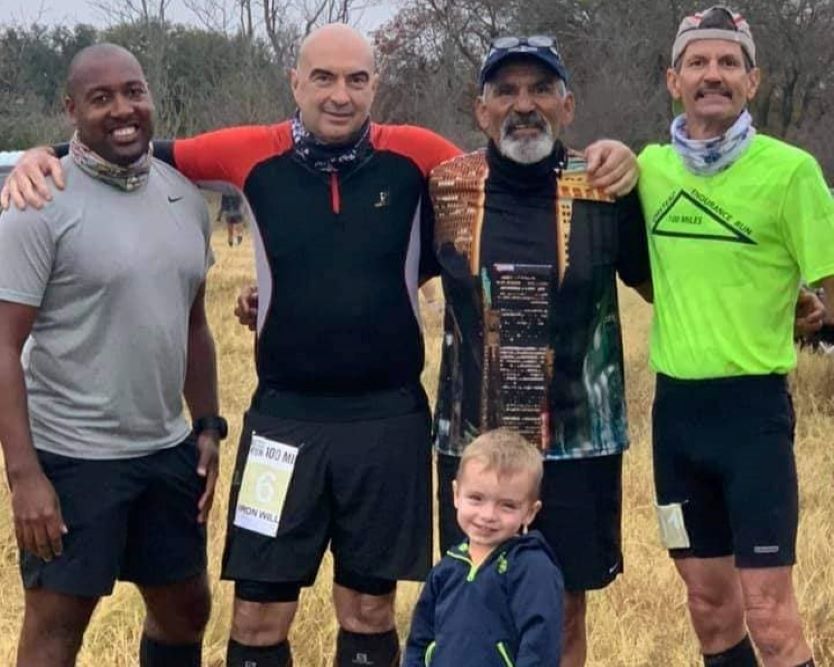
Will Sprouse (second from left) at the start of the Dinosaur Valley 100 Mile with Aubrey Calhoun, Rene Villalobos, Mike Smith, and chief pacer, Caysen.
Three days after that Texas race, he experienced a weird headache. “I sat down and the headache went away. I was at my restaurant,” he said.
But when he stood up, that’s when his face began to slump and his words slurred, indicating a stroke. Before the end of the night, he couldn’t see, swallow, or stand.
Following a few days in the intensive care unit at the hospital, his vision returned and he could swallow again but struggled to stand. The doctors found that he had a birth defect in his heart — a patent foramen ovale (PFO), which is a hole between the left and right atria, or upper chambers, of the heart. The hole exists in everyone before birth and most close naturally after birth. Though, some babies’ hearts don’t close and require a procedure to correct the defect.
“I’d never had any issues. I was healthy and had the stroke out of the blue. It was weird,” he said.
After one week, he was released into rehabilitation for another week before doing outpatient physical therapy in January 2021. First, he relearned to walk and run on grass, where he could fall over. Then his training routine was running one-fifth of a mile, followed by walking one-tenth of a mile, on repeat.
By February 14, he attempted a 100 miler, stepping out at mile 53. Two weeks later, he attempted another century distance, making it 75 miles. At his third 100-mile goal in March, he completed 43 miles. In April, he DNFed his next attempt, completing 75 miles.
Finally, he finished his first 100 miler post-stroke, the Honey Badger 100 Mile, on June 10, 2021. “I finished a 100 miler again. It was seven months after my stroke,” said Sprouse.
Running post-stroke is still not without its challenges for Sprouse. When he tries to run below a 12-minute mile, his heart rate shoots up to more than 200 beats per minute. “The part of my brain that controls that is dead,” explained Sprouse.
Instead, he has to pace himself at 14- to 15-minute miles instead of a 10- to 12-minute miles for a 100-mile race. Prior to the stroke, he cruised at a seven-minute mile pace.
Ultimately, his doctors would like to implant a pacemaker in his chest to help control the heartbeat. However, Sprouse has two big concerns: “I still have my pilot’s license, and I have my airplane and I fly. If I get a pacemaker, I can’t ever fly again. Besides owning a restaurant, I’m also a mechanic: I do refrigeration and electrical and plumbing work and with a pacemaker, you have to be careful working around motors. You can’t go around them, and I go around a lot of large motors. It would probably mean a career change and I’d lose my pilot’s license,” he shared.
At the moment, he does have a heart monitor, three neurologists, and four cardiologists that he works with every day. If his heartbeat looks irregular, a specialist contacts him right away.
“I was going to race a 100 miler in Texas called the Brazos Bend 100 Mile, in December 2021, and they called and said they didn’t like the way my heart looked. I dropped out at mile 31. It turned out to not be a big deal but they had me scared enough,” he said.
Also, his doctors support his running goals. “My body does better when I run than when I quit. My heart stops doing well when I stop exercising. When I run regularly, my heart beats more normal,” he explained.
To help him reenter ultrarunning after his stroke, Sprouse reached out to fellow ultrarunner Tom Green, who’d also experienced a stroke and returned to the sport. Talking with Green helped Sprouse know what to expect.
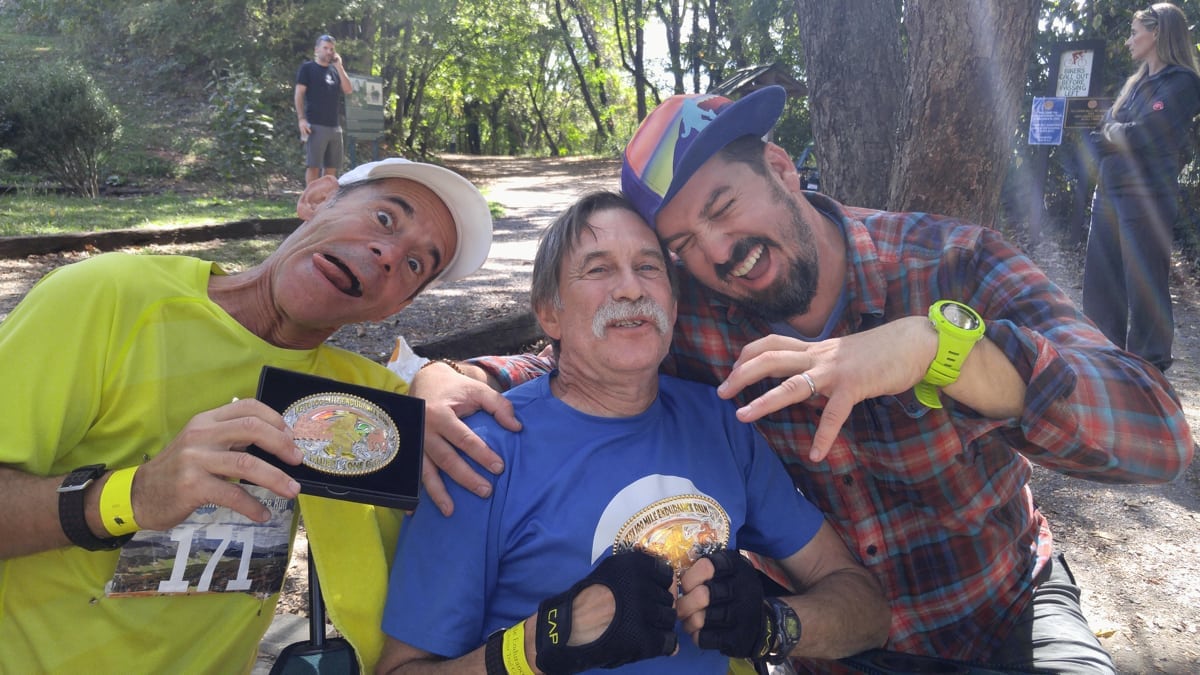
Tom Green (center), celebrating with Charlie Romanello and Jason Green at the end of the Yeti 100 Mile. Photo courtesy of Rita and Dick Fuller.
“Our problems were fairly identical — we both had balance issues and would both fall to our left. He runs with a stroller for balance. I started out running with a stroller for balance, but my problem was, when I’d fall, I’d fall over with the stroller, so I ditched it,” said Sprouse, who also began to struggle with finishing the 100-mile distance after his stroke. With his heart rate limitations, he needed more time than the standard time limit would allow.
“A lot of my DNFs were because I couldn’t finish 100 miles in less than 30 hours, which is pretty much the standard in 100 milers,” said Sprouse. Only a handful of 100-mile races have 36-hour cutoffs, such as the Honey Badger 100 Mile, so Sprouse decided to launch his own event that focuses on inclusivity and openness to adaptive athletes.
Based in Junction City, Kansas, the route of the Iron Will 100 Mile runs alongside a river, is 75% shaded, and maintains a flat silhouette with no rocks or roots. The time cutoff is 36 hours, and the trail is wide enough for someone who needs a wheelchair or stroller.
The aid stations are frequent, every five miles, and if the temperature is above 85 degrees Fahrenheit, another aid station will be added at the 2.5-mile mark. In addition to the 100-mile distance, racers can opt for the 50k or 50 miler. The flat, fast route is also conducive to ultrarunners who want to reach a PR in the 100-mile distance.
So far, Sprouse anticipates seeing Green, as well as Kent Bragg, who also ultra runs post-stroke, and another two runners from England and Missouri who also experienced strokes, take part in the event. He also reached out to another ultrarunning friend who has multiple sclerosis. And if someone needs a little more time than 36 hours, Sprouse is happy to be flexible with the finish time.
“Some race directors were nice and cool about my disability. I had three races in particular where I was registered before my stroke and they were hardcore, saying, ‘If you can’t do it, then you can’t do it.’ They didn’t have any sympathy. That’s fine though. That gave me the incentive to create a race that is disability-friendly,” shared Sprouse.
Sprouse’s new goal is to finish one hundred 100 milers, and he is three-quarters of the way through this, including nine 100 milers that he’s completed after his stroke, in 2020.
“I have to adapt and pick and choose races that are realistic for me now. When I first started to come back, I DNFed trail races that I easily finished before. It took me a while to realize I can’t do it anymore because of my disability. It’s tough, but once I get my hundred 100 milers, maybe I’ll go back to my favorite 100-mile courses and do the 50 milers instead,” he shared.
Today, he runs three to six miles per day, nonstop without walk breaks. He said, “It’s gotten better but I’m slower than normal. Before my stroke, I’d run 10 to 12 miles per day. I’m running half of what I used to, as far as distance goes, and at a lot slower pace. I’m still working on it.”
Sprouse also can’t feel his entire right side from his head to his toe, and his brain doesn’t trigger his right hamstrings or gluteal muscles, so he experiences muscle spasms and runs with a half stride.
Up ahead, Sprouse is focused on finishing his huge ultrarunning goal, including his first-ever 48-hour race, The Sticks 48 Hour in Kansas, followed by nine more 100 milers for 2022. In 2023, he plans to do another 15 100 milers, if all goes to plan.
Sprouse stays focused on what motivates him and never tires of the effort. He said, “I try to run my own race, and a lot of times good things happen later on. Most of all, I like the challenge.”
Call for Comments
- Have you ever run with Will Sprouse, and do you have any stories about him to share?
- Have you or anyone you know experienced racing after a stroke or similar illness?
- If so, what challenges have you found and what can race organizers do to be more inclusive of such runners?
